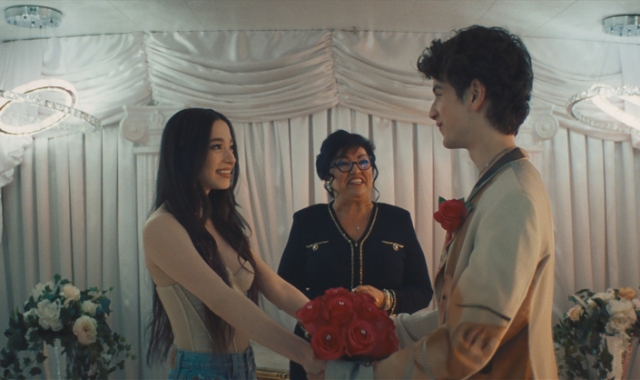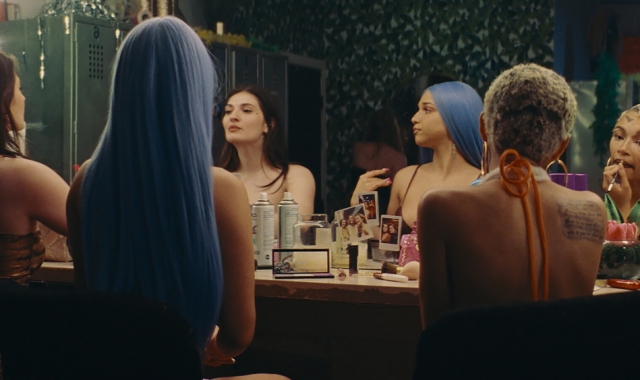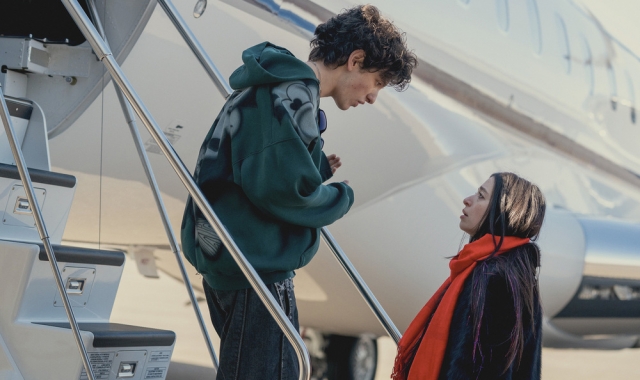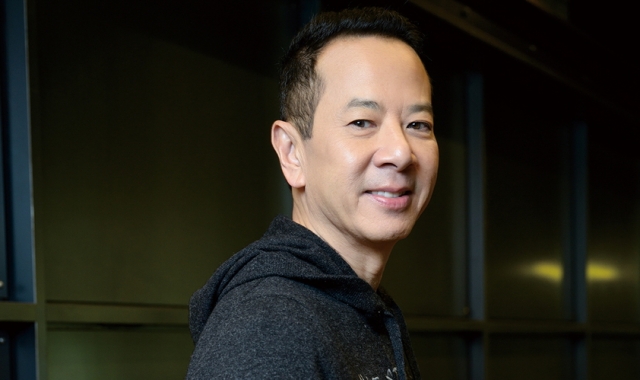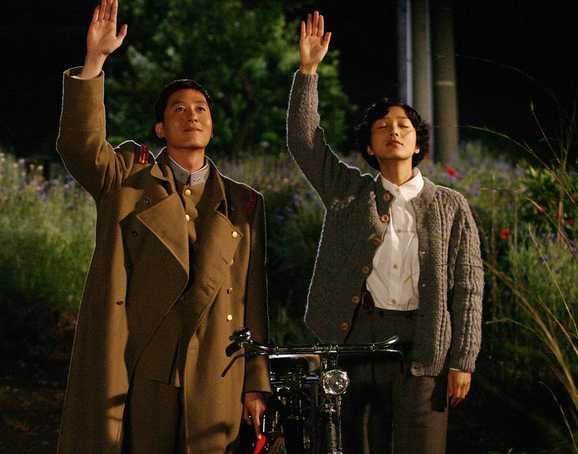
지난 5∼6년 동안 한국영화는 촬영, 사운드, 디지털 효과, 세트 디자인 등 여러 분야에서 지속적으로 기술적·예술적인 발전을 보여왔다. 이것은 한국영화 관람의 감각적인 쾌락을 더해줄 뿐만 아니라 감독들이 관객에게 생각과 감정을 전달하는 데 훨씬 방대한 가능성을 제공해주기도 했다. 이런 발전 중에는 항상 더 다양해지고 완성도 높아지는 영화음악의 제작이 있다. 이것은 부분적으로 다른 나라―특히 일본의―재능있는 작곡가들을 찾아냄으로써 성취되기도 했지만, 또한 한국의 젊은 인재들이 등단한 것도 있다. <달콤한 인생> 작업을 한 달파란과 장영규가 스페인 시체스 영화제 ‘최고 사운드트랙상’을 수상한 것도 한국 사운드트랙에 대해 증가된 관심의 한 예일 뿐이다.
그렇지만 감독들도 분명 때로는 의문을 품을 것이다. ‘전시대의 가장 위대한 인재들의 작품을 활용할 수 있는데, 현대 작곡가들만 쓸 일이 있나? 모차르트와 바흐의 작품은 이제까지 작곡된 음악 중에서 가장 표현이 풍부하고 숭고한 것으로 여겨지는데, 게다가 저작권도 만료돼서 모두 무료이지 않은가!’ 실제로 지난해 많은 한국영화들이 고전음악을 사용했다. 어떤 때는 유명한 주제곡을 새로운 작곡에 차용하기도 하고(<혈의 누>에서 라흐마니노프를 인용했던 것처럼), 또 때로는 <친절한 금자씨>에서처럼 원곡 형태를 그대로 사용하기도 했다. 최근 개봉한 <청연>이 특히 이런 면에서 야심찼는데, 흥분이 고조되는 비행 경연대회에서는 베토벤의 5번 교향곡을 인용했고, 낭만적인 장면에서는 말러의 5번 교향곡의 멋지고 느린 악장을 반복해서 크게 울려퍼지게 했다(심지어 어떨 땐 끝까지 들을 수도 있다).
그러나 장편영화에 이런 종류의 작품을 사용하는 것은 위험을 내포할 수도 있다. 일부러 영화에 넣기 위해 작곡된 음악은 서사의 목적에 충실하도록 주조된다. 가장 중요한 것은, 이런 영화음악은 화면상에 뭔가 중요한 일이 벌어지고 있을 땐 배경에 종속적으로 남아 있다가 나중에 특정 감정을 강조하기 위해 좀더 강력하게 나올 수 있다는 점이다. 훌륭한 작곡가의 연주음악은 좀 다르다. 이런 영화음악이 고양이처럼 부드럽고 포근하다는 대중적인 생각도 있지만, 실제 성질은 호랑이에 더 가깝다. 즉 우아하고, 예측 불가능하며, 힘이 있는 것이다. 호랑이가 구석에서 조용히 자고 있을 때조차도 그 존재는 무시할 수 없듯 말이다.
영화사에 큰 업적을 이룬 타르코프스키나 고다르 같은 감독들도 광범위하게 영화에 고전음악을 사용해왔다. 그래도 그럴 때면 우선순위가 분명하다. 음악이 먼저다. 큐브릭의 <2001: 스페이스 오딧세이>에서 그 유명한 <푸른 도나우> 인용이 주목할 만한 예다. 음악이 시작되면 우리는 꿈속으로 들어가는 듯하며, 음악이 끝난 후에야 계속해서 내러티브가 이어진다.
모든 것이 맞아떨어질 때 영화에서 고전음악의 사용은 두 가지 강력한 예술 형식의 융합으로 정말 흥미로워질 수 있다. 때로 큐브릭 감독이 우주에서 비엔나 왈츠를 사용한다든지, <올드보이>의 치아 뽑는 장면에 비발디 음악이 사용된다든지…. 이런 예기치 못한 조합에 의해 심지어 흥미로움이 더욱 고조되기도 한다. 그렇지만 감독들이 이런 작업을 성공적으로 하기 위해선 사자 조련사의 태도를 취해야 할 것 같다. 짐승들을 잘 달래어 이쪽저쪽 방향으로 가게 할 수는 있어도, 야수가 고양이인 양 꾸며대선 결코 안될 일이다.
Over the past five or six years, Korean cinema has seen continual technical and artistic advancement in fields such as cinematography, sound, digital effects, set design, and more. This not only adds to the sensual pleasure of watching Korean films, but it also gives directors a much wider range of possibilities for transmitting ideas and emotions to viewers. Among these advancements has been the production of ever more diverse and accomplished musical scores for films. Partly this has been accomplished by searching out talented composers from other countries --Japan in particular -- but there has also been an infusion of young Korean talent. The Best Soundtrack award presented to Dalparan and Jang Yeong-gyu at the Sitges festival in Spain for their work on A Bittersweet Life is only one example of the increased interest in Korean soundtracks.
Yet at times directors must ask, why limit ourselves to contemporary composers when we can make use of some of the greatest minds of all time? The works of Mozart or Bach rank as some of the most expressive, sublime music ever written, and what's more, the copyright has expired so it's all free! Indeed, the past year has seen a number of Korean films make use of classical music in their scores, sometimes adopting famous themes into new compositions (as with the quoting of Rachmaninov in the score of Blood Rain), and at other times using works in their original form, as in Sympathy For Lady Vengeance. The recent release Blue Swallow was particularly ambitious in this regard, quoting Beethoven's Fifth Symphony in the exciting flying competition and repeatedly cranking up the gorgeous slow movement from Mahler's Fifth Symphony in the more romantic scenes (sometimes we even get to hear it through to the end).
However there are dangers involved in placing works of this type into a feature film. Music composed especially for inclusion in a film is shaped to serve the purposes of a narrative. Most importantly, it can remain submissive in the background when something important happens onscreen, later to emerge more forcefully to underline a particular emotion. The concert music of the great composers is somewhat different. Despite the popular conception of it as something soft and cuddly, like a kitten, its true nature is closer to that of a tiger: graceful, unpredictable, and strong. Even when a tiger sleeps quietly in the corner, its presence is impossible to ignore.
Some of the most accomplished directors in history, such as Tarkovsky or Godard, have made extensive use of classical music in their films. When they do so, the priorities remain clear: the music comes first. Kubrick's famous quotation of "The Blue Danube" waltz in 2001: A Space Odyssey is a noteworthy example: when the music starts, it's like we enter a dream, and only after the music is over can we continue the narrative.
When everything falls into place, the use of classical music in cinema is truly exciting ? the convergence of two powerful art forms. Sometimes this is heightened even further by unexpected combinations, such as Kubrick's use of Viennese waltz music in space, or indeed the use of Vivaldi during the tooth-pulling scenes in Oldboy. Yet it seems that for directors to be successful in doing this, they must take on the attitude of a lion trainer. One can coax the animal in this or that direction, but one must never pretend that the beast is a kitten.



